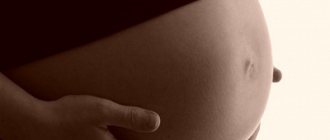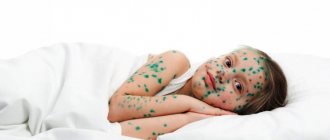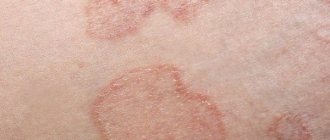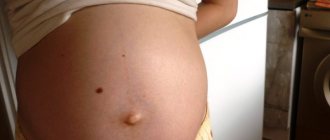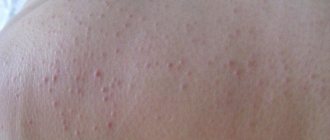Over nine months, significant changes occur in the expectant mother’s body, which negatively affect, first of all, the woman’s appearance, especially the condition of the skin. Also, during pregnancy, the mother’s immune system is significantly weakened, whose body must work in an enhanced mode to provide optimal conditions for both the woman herself and her baby.
With this regimen, any factor can provoke urticaria, from the immune relationship of the mother and the unborn child to the increased level of estrogen in the blood of the pregnant woman. Such processes negatively affect a woman’s skin, as a result of which blisters appear on them, which visually resemble a burn from the well-known nettle (hence the name of the disease), even if the patient has not previously had an allergy.
What kind of violation
The appearance of urticaria is a consequence of a decrease in the functioning of the immune system and changes in the hormonal system. The amount of estrogens increases, which can serve as an impetus for the development of diseases.
Pregnancy and urticaria are interrelated concepts, as the body undergoes a reconfiguration of the hormonal system. The body may react differently to such changes.
The rash appears in one place and then can affect other areas of the skin. If an allergy develops in the stomach of pregnant women, it can further affect the hips, buttocks, and legs.
The appearance of a rash on the face during pregnancy brings additional discomfort, as it affects appearance and mood.
Causes of rashes in pregnant women
Urticaria in pregnant girls is provoked by anything, even those things that previously did not cause absolutely no reaction. The body during pregnancy is especially vulnerable to any influences, as it is rebuilt and severe hormonal disruptions occur. An allergic skin reaction during pregnancy usually occurs due to:
- excessive production of estrogen in the body during pregnancy (this is the main reason);
- decreased immunity;
- gestosis (severe or late toxicosis);
- stress during pregnancy;
- decrease or increase in air temperature;
- climate change.
Provocateurs of an allergic reaction of the body with characteristic rashes are:
- pollen;
- dust;
- six animals;
- strong aromas;
- household chemicals;
- synthetic clothing;
- dyes;
- cold;
- insect saliva (gets into the wound when bitten);
- cosmetics;
- food products.
Urticaria, regardless of the cause, may appear for the first time during pregnancy or recur if it has already been observed before.
Causes
Urticaria during pregnancy has the same causes as during normal conditions. The condition is caused by an allergic reaction to food, chemicals, or insect bites. The presence of:
- liver pathologies;
- autoimmune inflammation (rejection of one’s own tissues);
- the appearance of parasites (giardia, worms);
- diseases of the endocrine system;
- presence of female diseases.
Immune conflict between mother and fetus - the risk of urticaria. Cold or, conversely, heat has an effect on the condition of the skin.
At the first manifestations of urticaria during pregnancy, immediately consult a doctor (venodermatologist or allergist).
Polymorphic dermatosis of pregnancy
A rash during pregnancy may be associated with diseases such as atopic dermatitis, cholestasis (also characteristic of the gestational period), polymorphic dermatosis, pephigoid (a type of herpes). It happens that before pregnancy a woman was not bothered by allergies or other skin diseases. But more often than not, there was still a predisposition to them (about every fifth patient with atopic dermatosis had signs of this pathology before).
In general, I diagnose dermatoses in pregnant women in approximately 3-5% of women, but it should be noted that with a mild course of the disease, not every expectant mother consults a doctor, so it is quite difficult to establish the true extent.
A rash on the abdomen during pregnancy most often appears in those women who have a hereditary predisposition to such diseases, including autoimmune pathologies and allergic reactions. Fortunately, after giving birth it goes away quite quickly.
It happens that a rash indicates infectious pathologies such as measles or rubella. In this case, additional symptoms characteristic of viral infections arise, from which the nature of the disease can be understood.
It accounts for more than 50% of rash cases. It usually causes a rash during early pregnancy. Other types of skin diseases appear later, but atopic dermatitis can occur as early as the first trimester. Caused by changes in immunity during pregnancy.
Practice shows that after childbirth in 80% of cases it goes away and does not bother the woman anymore. Such reactions manifest themselves as prurigo, eczema and itchy folliculitis. They pose no danger.
It is also a common pathology during the gestational period. Most often it is encountered in the third trimester. Provoking factors are multiple pregnancies and excess weight.
Associated with the skin stretching mechanism described above. The rash can look different. Does not cause complications during childbirth.
It is a fairly rare autoimmune pathology when the allergen is a placental antigen. Accompanied by itching and a rash in the form of blisters. It usually goes away after birth, but the baby may develop a rash.
Fortunately, this is a rarer disease compared to atopic dermatitis, since it causes complications such as fetoplacental insufficiency, premature birth, and so on. And in the postpartum period, problems may begin - for example, postpartum thyroiditis develops. In addition, during menstruation or while taking hormonal medications, there may be relapses of the disease.
All of these diseases require treatment, so you should definitely consult a doctor.
How it develops
Hives appear suddenly, remain on the body for up to 24 hours, and then may recur again. With relapses, the rash lasts longer. Then you feel itching and burning. There is a strong desire to constantly scratch the affected area.
Stages of development:
- acute;
- acute recurrent (exacerbation lasts up to 6 weeks);
- chronic form (more than 6 weeks).
The rash can take on a mild form, when up to 20 blisters appear on the body per day and do not cause concern. Average - 20-50 blisters with minor disturbances but not affecting sleep. Intensive form - more than 50 blisters per day, which cause irritation, itching, which interfere with normal sleep and daytime activity.
Sometimes rashes appear from the first days of conception and accompany the entire pregnancy. Most often, the appearance of the rash occurs in the third semester.
Sometimes the disease completely disappears immediately after childbirth. The reason is that stress disappears and hormonal balance improves.
Signs and symptoms
The main symptoms of urticaria include: the appearance of blisters on the skin, itching and burning, irritability and insomnia.
As a rule, urticaria on the abdomen is the first manifestation of the disease. Then it migrates to the chest, arms and face. Hives on the legs begin to appear in the buttocks and thighs, then it goes down to the legs and feet. Sometimes this disease is accompanied by other allergy symptoms: nasal congestion, lacrimation, sneezing, but most often - Quincke's edema of the lips and larynx, which has a similar development mechanism.
Why is it dangerous?
Urticaria during pregnancy does not harm the development of the fetus or the birth process. But it brings a lot of trouble and is unpleasant, which makes the expectant mother nervous.
The danger comes from the consequences of an allergic rash - the likelihood of Quincke's edema. As a result, hypoxia occurs, which can lead to inhibition in the physical and mental development of the baby.
If medical assistance is provided in time, the disorder will not affect the life and development of the fetus.
Forms of urticaria
In women who did not suffer from urticaria before pregnancy, the disease will occur in an acute form. In this case, signs of urticaria appear suddenly and the disease progresses rapidly. After a short time, the symptoms disappear and may not appear again.
In the case where the expectant mother has previously suffered from urticaria, the disease can occur in a chronic form with periodic relapses not only during pregnancy, but also after it.
Depending on the type of irritant that provokes urticaria, the following types of disease are distinguished:
- thermal;
- cold;
- aquagenic – for water, sweat and other liquids;
- dermatographic – with mechanical impact on the skin (bag straps, clothing items, bracelets, etc.);
- food;
- medicinal;
- cholinergic – with physical or emotional stress;
- adrenergic – during the release of adrenaline (for example, after stress).
If the cause of urticaria cannot be determined, then the disease is classified as idiopathic.
Diagnostic methods
Diagnosing urticaria during pregnancy is not easy, since the symptoms are very similar to dermatitis. It is recommended to get tested:
- blood (general, biochemical, for the presence of sexually transmitted diseases);
- urine;
- mucosal smears;
- hormone tests;
- feces to identify parasites.
Skin and provocative tests to detect allergens are not performed during pregnancy.
Rash prevention
To prevent a rash from appearing on the stomach during pregnancy, a woman should follow some recommendations:
- Follow a diet. While pregnant, the risk of developing food allergies increases. This is due to hormones, as well as the consumption of foods that do not combine well with each other.
- Refusal from uncontrolled use of medications. Reaction to medications is another cause of allergies, so you should avoid taking medications not prescribed by your doctor.
- Avoid synthetic and tight clothing. Synthetics provoke allergies, and squeezing things worsen the situation.
- Maintain personal hygiene. Regular showering, bathing, and using safe cosmetics are the best ways to prevent rashes.
- Application of moisturizing creams. To protect the skin and improve its elasticity, it is important to use special products or natural oils every day.
You also need to get rid of unnecessary stress and try not to worry about anything.
If a red itchy rash appears on your stomach, you should contact a dermatologist or therapist. This sign almost always requires additional diagnostics to exclude dangerous pathologies and processes in the body. Timely treatment will help quickly get rid of the rash and itching, and also prevent the psychological consequences of constant discomfort.
Source
Treatment
Treatment of urticaria during pregnancy is complicated by the ban on the use of many drugs and methods. The choice of treatment method depends on the cause of the rash. If possible, it is important to eliminate the allergen (remove dust, remove carpets, replace heavy fabric curtains with blinds), and monitor nutrition.
Therapy is carried out at home or in a hospital. The disease can be treated; it is important not to neglect your health.
The violation is accompanied by unpleasant symptoms, which is not favorable for the pregnant woman. It is important to minimize the irritating effect on the nervous system. Conditions when it is not worth intervening are determined by the doctor.
Medicines
Many drugs have undergone clinical trials and have minimal harm to the development of the fetus and do not cause the development of defects. To eliminate the rash and prevent the appearance of Quincke's edema, use:
- antihistamines;
- mast cell membrane stabilizers;
- glucocorticosteroids.
Potent drugs and hormonal injections are prescribed when there is a risk of maternal death.
The course of treatment is prescribed taking into account concomitant pathologies of the digestive and endocrine systems, and the presence of disturbances in the composition of the intestinal microflora. It is not recommended to take medications regularly during pregnancy; it is better to carry out prophylaxis after symptoms are relieved.
There is no safe drug treatment, so the doctor chooses it based on the state of health.
Folk remedies
Folk remedies have a mild effect on the fetus. It is recommended to use herbal baths to relieve symptoms (itching, burning).
It is useful to use nettle and elderberry. Prepare warm, but not hot, and add dried herbs in equal quantities. You can make a decoction separately, then pour it into the bath.
The procedure perfectly relaxes and fights hives. Chamomile with a string has a similar effect.
If you are allergic to herbs, then it is better to use another remedy. They practice taking a bath with starch. For this, 500 gr. starch is dissolved in 1 liter. water, then pour out the bath. Water procedures are taken for 15-20 minutes.
The ointment, which you make yourself, has a therapeutic effect.
- Grate 1-2 heads of garlic.
- Pour 200 gr. boiling water
- Place on the stove and evaporate some moisture over low heat.
- Add 100 gr. olive oil.
- ½ tbsp. l. beeswax.
When the mixture has thickened, apply to the affected areas. Apply until the rash disappears completely.
To calm the nervous system, it is useful to drink mint teas or infusions. To prepare the infusion 2 tbsp. l. mint, pour 300 ml boiling water. Leave for 1 hour, then, when it cools down, drink 50 ml 3 times a day.
Self-treatment without consulting a doctor is very dangerous for the life and health of the mother and child.
Diet for pregnant women with urticaria
Even in the absence of any health abnormalities, pregnant women need to follow a strict diet. And even more so with urticaria. To do this, the following foods will be excluded from the diet:
|
|
|
You need to be very attentive to the symptoms after consuming fermented milk products. Sometimes the body can react to them. If this happens, it is necessary to minimize their use. Women are prohibited from eating fatty meats. While carrying a child, you should give preference to healthy dietary varieties: turkey, rabbit, beef. A huge amount of vitamins and essential components enter the body with the consumption of cereals and cereals. The only “harmful” cereal is semolina. I advise you to lean on any types of cabbage and yellow vegetables.
I would like to give one more piece of advice - keep yourself a food diary. This attribute is very relevant at the time of gestation. Its essence is to record each meal, time, volume, body reaction and possible allergen. Registration is made daily, without gaps. This will help both you and the doctor identify the causes and quickly relieve you of the disease.
How to treat a rash during pregnancy?
Since any rash occurs as a result of various diseases, to eliminate it, you need to treat the reason why it occurred. In order to prevent the appearance of an unpleasant rash, it is important to adhere to personal hygiene, eat right, and exclude from the diet those foods that can cause allergic reactions. If you have allergies you need to use antihistamines. They are available in the form of tablets, ointments, drops.
We also recommend reading: Tingling in the uterus during pregnancy
When the rash is infectious, you should not self-medicate, but strictly adhere to the recommendations of a specialist doctor.
Remember: if you notice the problem in time and go to the hospital for help, both you and your baby will not suffer. You can treat rashes at home only with the permission of a doctor and in no other way. Be vigilant about your health and then everything will be fine.
Malfunctions of internal organs
There are cases when a rash on the body of a pregnant woman appears as a result of a disruption in the functioning of various internal organs, which may not cope with the increased load. This very often manifests itself in the form of a rash that forms not only on the surface of the abdomen, but also on other parts of the body.
Most often, this is precisely the dysfunction of the gallbladder or liver. This may occur as a result of the fact that the woman has taken some medications that have a negative effect on the liver, or the growing fetus begins to put a lot of pressure on the bile ducts, as a result of which bile cannot exit properly.
You can also alleviate a woman’s condition by using a good moisturizer, which should be completely natural. It is important to remember that allergic rashes appear quite often as a result of using low-quality or inappropriate creams for stretch marks. Therefore, in order to prevent the appearance of unsightly stripes on the surface of the skin, which will be quite difficult to get rid of after childbirth, it is recommended to resort only to natural and safe methods - for example, the use of simple olive oil, a small amount of which is applied to problem areas of the skin, is very effective. The main thing is to do such cosmetic procedures regularly, and then you don’t have to worry about the fact that stretch marks may appear.
Herbal compresses or rubbing can also help relieve unpleasant itching. However, one must be extremely careful when using herbs, as some herbs can provoke a fairly strong allergic reaction. The ideal option would be to take simple baking soda (one teaspoon) and dissolve it in boiled water (half of one glass).
Recommendations
Antiallergic therapy during pregnancy is aimed at relieving negative symptoms and minimizing the consequences. This means that when treating urticaria, you should avoid taking antihistamines and hormonal drugs in every possible way. They are only necessary in severe cases. If you can do without them, then it is better to refrain from using pharmaceuticals. There are definitely no negative consequences expected.
Homeopathic remedies are also not recommended for the treatment of urticaria, because their effect is zero, and the effect on the fetus can be detrimental.
The best option is to follow all preventive measures, limit contact with the allergen, and use safe ointments, creams, and gels for allergies. All other drugs are prescribed only by a doctor and used under his supervision. Only in this case can you count on safe therapy without consequences for the fetus.



